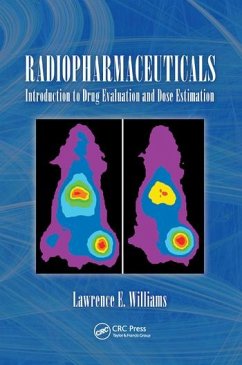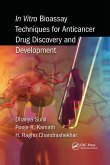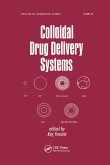- Broschiertes Buch
- Merkliste
- Auf die Merkliste
- Bewerten Bewerten
- Teilen
- Produkt teilen
- Produkterinnerung
- Produkterinnerung
This comprehensive overview details the process of radiopharmaceutical development, from cellular studies to animal experiments to the design and implementation of clinical trials. It compares various radiopharmaceuticals and provides guidance on dose estimation and agent selection, covering standard medical internal radiatio
Andere Kunden interessierten sich auch für
![Pharmaceutical Inhalation Aerosol Technology, Third Edition Pharmaceutical Inhalation Aerosol Technology, Third Edition]() Pharmaceutical Inhalation Aerosol Technology, Third Edition69,99 €
Pharmaceutical Inhalation Aerosol Technology, Third Edition69,99 €![Cancer Inhibitors from Chinese Natural Medicines Cancer Inhibitors from Chinese Natural Medicines]() Jun-Ping XuCancer Inhibitors from Chinese Natural Medicines66,99 €
Jun-Ping XuCancer Inhibitors from Chinese Natural Medicines66,99 €![Enhancement in Drug Delivery Enhancement in Drug Delivery]() Enhancement in Drug Delivery85,99 €
Enhancement in Drug Delivery85,99 €![Quantitative Structure - Activity Relationship Quantitative Structure - Activity Relationship]() Siavoush DastmalchiQuantitative Structure - Activity Relationship64,99 €
Siavoush DastmalchiQuantitative Structure - Activity Relationship64,99 €![In Vitro Bioassay Techniques for Anticancer Drug Discovery and Development In Vitro Bioassay Techniques for Anticancer Drug Discovery and Development]() Dhanya SunilIn Vitro Bioassay Techniques for Anticancer Drug Discovery and Development64,99 €
Dhanya SunilIn Vitro Bioassay Techniques for Anticancer Drug Discovery and Development64,99 €![Topical Nail Products and Ungual Drug Delivery Topical Nail Products and Ungual Drug Delivery]() Topical Nail Products and Ungual Drug Delivery85,99 €
Topical Nail Products and Ungual Drug Delivery85,99 €![Colloidal Drug Delivery Systems Colloidal Drug Delivery Systems]() Jorg KreuterColloidal Drug Delivery Systems84,99 €
Jorg KreuterColloidal Drug Delivery Systems84,99 €-
-
-
This comprehensive overview details the process of radiopharmaceutical development, from cellular studies to animal experiments to the design and implementation of clinical trials. It compares various radiopharmaceuticals and provides guidance on dose estimation and agent selection, covering standard medical internal radiatio
Produktdetails
- Produktdetails
- Verlag: Taylor & Francis Ltd (Sales)
- Seitenzahl: 326
- Erscheinungstermin: 30. Juni 2020
- Englisch
- Abmessung: 234mm x 156mm x 18mm
- Gewicht: 458g
- ISBN-13: 9780367577056
- ISBN-10: 0367577054
- Artikelnr.: 69891512
- Verlag: Taylor & Francis Ltd (Sales)
- Seitenzahl: 326
- Erscheinungstermin: 30. Juni 2020
- Englisch
- Abmessung: 234mm x 156mm x 18mm
- Gewicht: 458g
- ISBN-13: 9780367577056
- ISBN-10: 0367577054
- Artikelnr.: 69891512
Lawrence E. Williams, Ph.D., is a professor of radiology and an imaging physicist at City of Hope National Medical Center in Duarte, California. In addition, he is an adjunct professor of radiology at University of California-Los Angeles (UCLA). While in high school, he was one of 40 national winners of the Westinghouse (now Intel) Science Talent Search. Dr. Williams obtained his B.S. from Carnegie Mellon University and his M.S. and Ph.D. degrees (both in physics) from the University of Minnesota, where he was a National Science Foundation (NSF) fellow. His initial graduate training was in nuclear reactions at Minnesota, where he demonstrated excited states of the mass-4 system (4He*). He later extended this work by finding excited levels of mass-3 nuclides while working at the Rutherford High Energy Laboratory in England. Since obtaining the National Institutes of Health (NIH) support to become a medical physicist, Dr. Williams has devoted most of his research to tumor detection and treatment and has written approximately 250 total publications as well as a number of patents in nuclear imaging and radionuclide therapy. He is a coauthor of Biophysical Science (Prentice Hall, 1979) and editor of Nuclear Medicine Physics (CRC Press, 1987). He has been a grant and site reviewer for NIH since the mid-1990s. Dr. Williams is associate editor of Medical Physics and a reviewer for several other journals. He is a member of the American Association of Physicists in Medicine (AAPM), the Society of Nuclear Medicine, the New York Academy of Sciences, Sigma Xi, Society of Imaging Informatics in Medicine (SIIM), and the Society of Breast Imaging. Dr. Williams has received a lifetime service award from the American Board of Radiology. Among Dr. Williams' most significant biophysical discoveries is the mass-law for tumor uptake as a function of tumor size. He was also codiscoverer (with Richard Proffitt) of tumor targeting with liposomes. This work involved one of the first applications of normal organ blockage by use of an unlabeled agent-that is, a two-step process. Dr. Williams has developed a pair of indices for quantifying the ability of a radiopharmaceutical to permit imaging or therapy of lesions in animals or patients. He has also demonstrated that radioactive decay must be considered inherently as one possible exit route in modeling analysis of radioactive drugs. With his colleagues at City of Hope, Dr. Williams measured and calculated the brake radiation dose result for a source of 90Y in a humanoid phantom. This study remains as one of the few examples of a comparison of dose estimates and measurement in the nuclear medicine literature.
Tumor Targeting and a Problem of Plenty. Preclinical Development of
Radiopharmaceuticals and Planning of Clinical Trials. Selection of
Radiopharmaceuticals for Clinical Trials. Absorbed Dose Estimation and
Measurement. Determination of Activity In Vivo. Modeling and Temporal
Integration. Functions Used to Determine Absorbed Dose Given Activity
Integrals. Absorbed Dose Estimates without Clinical Correlations. Dose
Estimates and Correlations with Laboratory and Clinical Results.
Multiple-Modality Therapy of Tumors. Allometry (Of Mice and Men). Summary
of Radiopharm-aceuticals and Dose Estimation. Index.
Radiopharmaceuticals and Planning of Clinical Trials. Selection of
Radiopharmaceuticals for Clinical Trials. Absorbed Dose Estimation and
Measurement. Determination of Activity In Vivo. Modeling and Temporal
Integration. Functions Used to Determine Absorbed Dose Given Activity
Integrals. Absorbed Dose Estimates without Clinical Correlations. Dose
Estimates and Correlations with Laboratory and Clinical Results.
Multiple-Modality Therapy of Tumors. Allometry (Of Mice and Men). Summary
of Radiopharm-aceuticals and Dose Estimation. Index.
Tumor Targeting and a Problem of Plenty. Preclinical Development of
Radiopharmaceuticals and Planning of Clinical Trials. Selection of
Radiopharmaceuticals for Clinical Trials. Absorbed Dose Estimation and
Measurement. Determination of Activity In Vivo. Modeling and Temporal
Integration. Functions Used to Determine Absorbed Dose Given Activity
Integrals. Absorbed Dose Estimates without Clinical Correlations. Dose
Estimates and Correlations with Laboratory and Clinical Results.
Multiple-Modality Therapy of Tumors. Allometry (Of Mice and Men). Summary
of Radiopharm-aceuticals and Dose Estimation. Index.
Radiopharmaceuticals and Planning of Clinical Trials. Selection of
Radiopharmaceuticals for Clinical Trials. Absorbed Dose Estimation and
Measurement. Determination of Activity In Vivo. Modeling and Temporal
Integration. Functions Used to Determine Absorbed Dose Given Activity
Integrals. Absorbed Dose Estimates without Clinical Correlations. Dose
Estimates and Correlations with Laboratory and Clinical Results.
Multiple-Modality Therapy of Tumors. Allometry (Of Mice and Men). Summary
of Radiopharm-aceuticals and Dose Estimation. Index.








